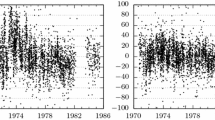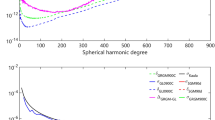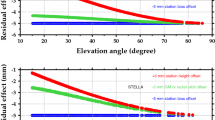Abstract
Understanding the structure of and dynamic processes in the deep interior of planets is crucial for understanding their origin and evolution. An effective way to constrain them is through observation of rotation and subsequent simulation. In this paper, a numerical model of the Moon’s rotation and orbital motion is developed based on previous studies and implemented independently. The Moon is modeled as an anelastic body with a liquid core. The equations of the rotation were nonlinear and the Euler angles are cross coupled. We solve them numerically via the Runge-Kutta-Fehlberg (RKF) and multi-steps Adams-Bashforth-Moulton (ABM) predictor-corrector numerical integration. We have found that adequate accuracy is maintained by taking twelve steps per day using eleventh differences in the integrating polynomial. The lunar orbital and rotational equations are strongly coupled, so we integrated the rotation and motion simultaneously. We refer to other planetary informations from the newest planetary and lunar ephemeris INPOP17a, which is reported had fitted the longest LLR (Lunar Laser Ranging) observation data. Using the model GL660B from GRAIL (Gravity Recovery and Interior Laboratory) mission, we firstly compare our numerical results with the INPOP17a to prove the reasonability of our model. After that we apply the lunar gravity model CEGM02 determined from Chang’E-1 mission and SGM100h from SELENE mission to our model, the difference between results from CEGM02 and GL660B are less than \(-0.20 \sim0.15\) arc-second, and \(-0.25 \sim0.20\) arc-second for GL660B and SGM100h. Compared to SGM100h, the results show that the low degree and order coefficients (less than 6 from this paper) of lunar gravity field were improved in CEGM02 as expected. It is the first time to demonstrate that these models can be applied to lunar rotation model. These results manifest that a development of the gravity field measure will help us to know the rotation motion more precisely.







Similar content being viewed by others
References
Cappallo, R., King, R., Counselman, C., Shapiro, I.: Moon Planets 24(3), 281 (1981)
Dickey, J.O., Bender, P.L., Faller, J.E., Newhall, X.X., Ricklefs, R.L., Ries, J.G., Shelus, P.J., Veillet, C., Whipple, A.L., Wiant, J.R.: Science 265(5171), 482 (1994)
Diethelm, K., Ford, N.J., Freed, A.D.: Nonlinear Dyn. 29(1–4), 3 (2002)
Eckhardt, D.H.: In: International Astronomical Union Colloquium, vol. 63, p. 193. Cambridge University Press, Cambridge (1981a)
Eckhardt, D.H.: Moon Planets 25(1), 3 (1981b)
Folkner, W.M., Williams, J.G., Boggs, D.H.: IPN Progress Report 42-178 (2008)
Folkner, W.M., Williams, J.G., Boggs, D.H., Park, R.S., Kuchynka, P.: IPN Progress Report 42-196 (2014)
Hofmann, F., Müller, J.: Class. Quantum Gravity 35(3), 035015 (2018)
Isenberg, C.: Eur. J. Phys. 18(2) (1997)
Kaula, W.: Theory of Satellite Geodesy p. 98. Blaisdell, Waltham (1966)
Konopliv, A., Binder, A., Hood, L., Kucinskas, A., Sjogren, W., Williams, J.: Science 281(5382), 1476 (1998)
Konopliv, A.S., Asmar, S.W., Carranza, E., Sjogren, W.L., Yuan, D.N.: Icarus 150(1), 1 (2001)
Konopliv, A.S., Park, R.S., Yuan, D.-N., Asmar, S.W., Watkins, M.M., Williams, J.G., Fahnestock, E., Gerhard, K., Paik, M., Strekalov, D., et al.: J. Geophys. Res. 118(7), 1415 (2013)
Lemoine, F.G., Goossens, S., Sabaka, T.J., Nicholas, J.B., Mazarico, E., Rowlands, D.D., Loomis, B.D., Chinn, D.S., Caprette, D.S., Neumann, G.A., et al.: J. Geophys. Res. 118(8), 1676 (2013)
Matsumoto, K., Goossens, S., Ishihara, Y., Liu, Q., Kikuchi, F., Iwata, T., Namiki, N., Noda, H., Hanada, H., Kawano, N., et al.: J. Geophys. Res., Planets 115(E6), E06007 (2010)
Namiki, N., Iwata, T., Matsumoto, K., Hanada, H., Noda, H., Goossens, S., Ogawa, M., Kawano, N., Asari, K., Tsuruta, S., et al.: Science 323(5916), 900 (2009)
Ouyang, Z., Li, C., Zou, Y., Zhang, H., Lu, C., Liu, J., et al.: Chin. J. Space Sci. 30(5), 392 (2010)
Pavlis, N.K., Holmes, S.A., Kenyon, S.C., Factor, J.K.: J. Geophys. Res., Solid Earth 117(B4), B04406 (2012)
Pavlov, D.A., Williams, J.G., Suvorkin, V.V.: Celest. Mech. Dyn. Astron. 126(1–3), 61 (2016)
Petrova, N., Zagidullin, A., Nefedyev, Y., Kosulin, V., Andreev, A.: Adv. Space Res. 60(10), 2303 (2017)
Ping, J., Li, W., Han, S., Zhang, T., Wang, M., Wu, G., Wang, Z., Cao, J., Jian, N., Yang, Y., et al.: Sci. China, Phys. Mech. Astron. 47(5), 059508 (2017)
Press, W.H., Teukolsky, S.A., Vetterling, W.T., Flannery, B.P.: Numerical Recipes 3rd Edition: The Art of Scientific Computing. Cambridge University Press, Cambridge (2007)
Rambaux, N., Williams, J.G.: Celest. Mech. Dyn. Astron. 109(1), 85 (2011)
Schuh, H., Behrend, D.: J. Geodyn. 61(61), 68 (2012)
Simos, T.: Comput. Math. Appl. 25(6), 95 (1993)
Standish, E.: JPL planetary and lunar ephemerides, de405, Interoffice Memo. 312. Technical report, F-98-048. Jet Propulsion Laboratory, Pasadena, California (1998)
Toksöz, M.N., Dainty, A.M., Solomon, S.C., Anderson, K.R.: Rev. Geophys. 12(4), 539 (1974)
Urban, S.E., Seidelmann, P.K.: In: American Astronomical Society Meeting Abstracts, vol. 223 (2014)
Vasilyev, M., Yagudina, E.: Sol. Syst. Res. 48(2), 158 (2014)
Viswanathan, V.: Improving the dynamical model of the moon using lunar laser ranging (LLR) and spacecraft data. PhD thesis, Paris Sciences et Lettres (2017)
Viswanathan, V., Fienga, A., Gastineau, M., Laskar, J.: Notes Scientifiques et Techniques de l’Institut de Mécanique Céleste, 108 (2017), 39 pp. ISBN 2-910015-79-3
Viswanathan, V., Fienga, A., Minazzoli, O., Bernus, L., Laskar, J., Gastineau, M.: Mon. Not. R. Astron. Soc. 476(2), 1877 (2018)
Weber, R.C., Lin, P.-Y., Garnero, E.J., Williams, Q., Lognonne, P.: Science 331(6015), 309 (2011)
Williams, J.G., Boggs, D.H., Yoder, C.F., Ratcliff, J.T., Dickey, J.O.: J. Geophys. Res., Planets 106(E11), 27933 (2001)
Yagudina, E.: In: Proceedings of Journees (2008)
Yan, J.G., Ping, J.S., Huang, Q., Cao, J.F.: Adv. Space Res. 46(1), 50 (2010)
Yan, J., Goossens, S., Matsumoto, K., Ping, J., Harada, Y., Iwata, T., Namiki, N., Li, F., Tang, G., Cao, J., et al.: Planet. Space Sci. 62(1), 1 (2012)
Yang, Y.-Z., Li, J.-L., Ping, J.-S., Hanada, H.: Res. Astron. Astrophys. 17(12), 127 (2017)
Yoder, C.: In: Natural and Artificial Satellite Motion, p. 211 (1979)
Acknowledgements
We are grateful to A. Fienga (Geoazur/IMCCE) for providing the initial lunar core angular velocity used in the INPOP17a.
Gravity model of GRAIL GL660B is downloaded from National Aeronautics and Space Administration (NASA), and gravity model of SGM100h is downloaded from National Astronomical Observatory of Japan (NAOJ). This research is supported by the National Natural Science Foundation of China (U1831132, 41590851), grant of Hubei Province Natural Science (2015CFA011, 2018CFA087), Open Project of Lunar and Planetary Science Laboratory, Macau University of Science and Technology (FDCT 119/2017/A3), Open Funding of Guizhou Provincial Key Laboratory of Radio Astronomy and Data Processing (KF201813), and State Key Project for Science and Technology (2015CB857101).
Author information
Authors and Affiliations
Corresponding author
Electronic Supplementary Material
Below is the link to the electronic supplementary material.
Rights and permissions
About this article
Cite this article
Yang, Y., Ping, J., Yan, J. et al. Comparison and analysis on lunar rotation with lunar gravity field models. Astrophys Space Sci 363, 190 (2018). https://doi.org/10.1007/s10509-018-3413-z
Received:
Accepted:
Published:
DOI: https://doi.org/10.1007/s10509-018-3413-z




